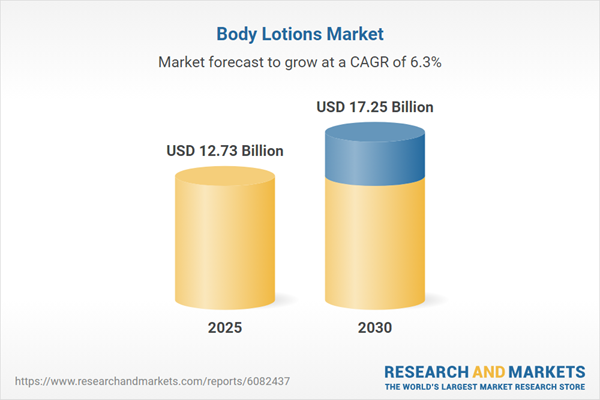Speak directly to the analyst to clarify any post sales queries you may have.
The body lotions market is at the center of swift transformation, as evolving consumer wellness priorities, digital integration, and sustainability demands create new benchmarks for growth and innovation. This executive overview delivers critical intelligence for senior leaders aiming to navigate complexity, mitigate risk, and outpace change within a dynamic global skincare landscape.
Market Snapshot: Body Lotions Market Growth and Forecast
The body lotions market grew from USD 11.97 billion in 2024 to USD 12.73 billion in 2025. It is expected to maintain a robust CAGR of 6.43%, reaching USD 19.72 billion by 2032. This steady expansion is powered by increasing demand for skin health solutions, eco-friendly product formulations, and the accelerating migration to digital commerce platforms across regions.
Scope & Segmentation: Categories, Regions, and Technologies
Market segmentation provides a granular view for strategic planning and resource allocation. The research scope encompasses a comprehensive range of distribution channels, consumer segments, pricing strategies, and product innovations.
- Distribution Channels: Brick-and-mortar outlets such as convenience stores, pharmacies, specialty stores, supermarket and hypermarkets, as well as online via brand websites, general e-commerce platforms, social commerce, and specialty retailers.
- Product Types: Body creams, lotions, gel lotions, spray lotions—each addressing varying moisture needs and consumer preferences.
- Skin Types: Products tailored for dry, normal, oily, and sensitive skin ensure diverse consumer inclusion and unique ingredient profiles.
- End Users: Solutions customized for kids, men, unisex categories, and women, supporting demographic-specific positioning.
- Price Range: Segmented offerings across economy, luxury, mid-range, and premium tiers support both volume and value-driven strategies.
- Formulation: Coverage of conventional and organic product standards, addressing both natural and established chemistry preferences.
- Application Site: Detailed focus on body, feet, and hands with tailored delivery and benefits per application area.
- Regions Covered: Americas (North America, Latin America), EMEA (Europe, Middle East, Africa), and Asia-Pacific populate the geographic focus, with each featuring mature and high-growth subregions.
- Technologies: Digital personalization tools, direct-to-consumer platforms, clean-label certifications, and advanced delivery systems such as microencapsulation and lipid-based carriers frame the innovation agenda.
Key Takeaways: Strategic Insights for Senior Leaders
- Growing environmental awareness is driving uptake of recyclable packaging, cleaner formulations, and transparent supply chains across all regions.
- Digital transformation is reshaping consumer interaction, with data-driven personalization and AI-facilitated skincare recommendations creating new loyalty drivers.
- The surge in e-commerce and social commerce broadens reach and highlights the need for omnichannel distribution strategies to capture both impulse and considered purchases.
- Product innovation is stimulated by green chemistry advances, with rapid deployment of plant-based and bioactive ingredients in response to evolving regulatory and consumer demands.
- Segmented price tiers, from value to luxury, allow brands to address diverse consumer aspirations while managing margin pressures and promoting distinct value propositions.
- Emerging regional differentiation necessitates localised product development and region-specific marketing to adapt to cultural nuances and regulatory standards.
Tariff Impact: Navigating Trade-Induced Complexity
Recent United States tariff measures have introduced notable pressures on imported specialty ingredients, packaging, and raw materials. Manufacturers are shifting supply chain strategies, fostering regional partnerships, and exploring nearshoring to control costs while maintaining quality. This trend prompts proactive scenario planning and integrated supplier engagement to balance cost efficiency against product performance.
Methodology & Data Sources
This analysis applied a rigorous multi-stage methodology, blending extensive secondary research of public documents and regulatory filings with primary interviews of senior value chain stakeholders. Market sizing and segmentation were cross-validated through data triangulation, expert reviews, and quality assurance checks to ensure findings are both reliable and actionable.
Why This Report Matters
- Enables executives to benchmark against best-in-class strategies in sustainability, digital commerce, and product innovation.
- Informs scenario planning and opportunity identification by clarifying regional distinctions and shifting regulatory dynamics.
- Delivers evidence-based insights for capitalizing on emerging growth levers, mitigating tariff impacts, and outpacing competitors in evolving segments.
Conclusion
The body lotions market presents clear opportunities for agile, well-informed decision-makers committed to innovation, differentiated value, and global expansion. Access to in-depth market segmentation and robust trend analysis empowers strategic navigation in a fast-moving sector. Leverage these insights to fortify market presence and anticipate industry shifts with confidence.
Table of Contents
3. Executive Summary
4. Market Overview
7. Cumulative Impact of Artificial Intelligence 2025
Samples

LOADING...
Companies Mentioned
The key companies profiled in this Body Lotions market report include:- Unilever PLC
- L'Oréal S.A.
- Beiersdorf AG
- Johnson & Johnson
- The Procter & Gamble Company
- The Estée Lauder Companies Inc.
- Shiseido Company, Limited
- Kao Corporation
- Amorepacific Corporation
- Colgate-Palmolive Company
Table Information
| Report Attribute | Details |
|---|---|
| No. of Pages | 186 |
| Published | October 2025 |
| Forecast Period | 2025 - 2032 |
| Estimated Market Value ( USD | $ 12.73 Billion |
| Forecasted Market Value ( USD | $ 19.72 Billion |
| Compound Annual Growth Rate | 6.4% |
| Regions Covered | Global |
| No. of Companies Mentioned | 11 |









